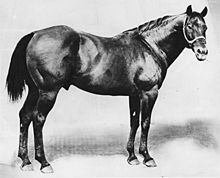 Mention “the King” in Western riding circles and it won’t be Elvis that comes to mind, but a bay stallion that set the standard for style and performance during the first decades the American Quarter Horse Association.
Mention “the King” in Western riding circles and it won’t be Elvis that comes to mind, but a bay stallion that set the standard for style and performance during the first decades the American Quarter Horse Association.
King P-234 (1932 –1958) was a son of a famous racehorse known north and south of the Rio Grande as Zantanon, the Mexican Man O’War. King’s dam was purportedly a Quarter mare named Jabalina, recorded in the first studbook as sired by Yellow Jacket and out of an unknown mare. Her sire was changed in the second edition to Strait Horse by Yellow Jacket.
Early day Quarter Horse ancestry offered a patchwork of pedigrees, some substantiated, many not. The American Quarter Horse Association, founded in 1940, was established with the purpose of defining breed standards. Association “inspectors” examined applicants in the flesh for registration and documented their pedigrees as best they could.
Since a lot of people cared more about a horse’s usefulness than its breeding, pedigrees were often irrelevant to pre-registry owners. Quarter Horse names from the first part of the 20th century reflect the emphasis on physical traits, as well as on the reputation of the horses’ breeders. Names such as Yellow Jacket, the Strait Horse, Dr. Rose mare, and Jabalina (alternately Javalina) were the norm; often-different horses had the same name.
There were three mares in the 1920s and 1930s, for instance, which were named Jabalina. One of them was the dam of King P-234. Exactly which one will probably never be known. But her identity caused somewhat of a stir in the late 1950s, when former AQHA historian Franklin Reynolds published the booklet King Was Not a Quarter Horse, based on his research and first-hand interviews.
It was Reynolds’ contention, backed by an affidavit signed by John Strait, and a pedigree attested to by Fred Binkley, that King was out of a mare whose paternal, as well as maternal grandsire was Barrington, a registered American Saddle Horse (Saddlebred) with Standardbred ancestry.
Fred Brinkley was the breeder of the Jabalina sired by a Barrington son and out of a Barrington daughter. This Jabalina later belonged to Benavides Volpe, the man who bred King. Another Jabalina, sired by a son of Sykes Rondo, was sold to the U.S. Army Remount Service for breeding purposes.
None of this matters today, in light of King’s stature as a cornerstone of the breed. It seems it would even have been a tempest in a teapot in the 1950s, considering that the bottom side of all three Jabalina pedigrees was blank. Nevertheless, it remains an interesting footnote in the history of the American Quarter Horse.
